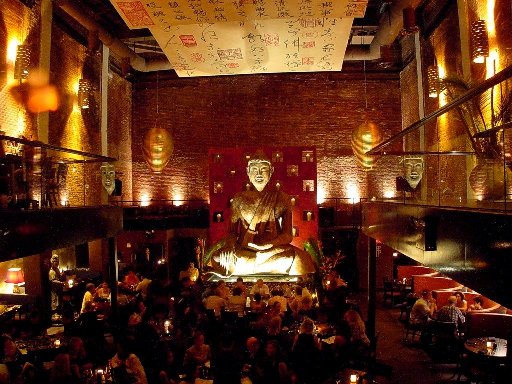Before the Buddha became all Bodhi, he did Shamatha and sustained Samadhi. But much like Einstein took Newtonian physics one step further or the Beatles improved on Elvis, the Buddha saw that something good could be made better. The problem with the Jhanas, or Samadhi, or the concentration realms as ultimate practice, thought pre-Buddha Buddha, is that when they end they are over and the world still exists and most of the time it’s an irksome schlep.
So the reason we’re indebted to Shakyamuni Buddha, is that he developed insight practice as an accompaniment to concentration, and in doing so sorted out the problem with living. And while he said it lots of ways, many would argue that the firmament of Buddhist insight re: life problems is the Three Characteristics (also known as Three Doors, Three Dharma Seals, etc.), which point to our fundamental confusion. The three characteristics are no-self, impermanence and suffering. All phenomena, everything that arises in our experience is non-referential, unstable and unsatisfying. As a result, we, comprised of that un-localized and shifting phenomena, do not exist. That idea YOU had for a screenplay? – Made up of every book you ever read, every movie you ever saw and the 1987 Thanksgiving at Aunt Edna’s. YOUR love for asiago? Comprised of DNA and taste buds and current food trends and your upbringing. That dream in which you are a child-doll-elephant ruler in a world of subjects made of matchsticks? Probably the asiago.
For the first part of Hardcore Dharma last night, we discussed the problem of non-self versus awareness. What is awareness if we don’t posses a solid, unchanging, permanent core?
In class, Ethan quoted this passage from Daniel Ingram’s Mastering the Core Teachings of the Buddha from his Chapter No Self vs. True Self:
“You see, as all phenomena are observed, they cannot possibly be the observer. Thus, the observer, which is awareness and not any of the phenomena pretending to be it, cannot possibly be a phenomenon and thus is not localized and doesn’t exist. This is no-self. However, all of these phenomena are actually us from the point of view of non-duality and interconnectedness, as the illusion of duality is just an illusion. When the illusion of duality permanently collapses in final awakening, all that is left is all of these phenomena, which is True Self, i.e. the lack of a separate self and thus just all of this as it is. Remember however, that no phenomena abide for even an instant, and so are empty of all permanent abiding and this of stable existence.” ***
Wrap your mind around that. Or don’t. In class many people were trying to clarify the “thing” that is awareness. I was shifting around in my seat, my mind blaring: “It’s not a thing. It’s not an a. It’s movement. It’s the movement of the question ‘what is awareness?’.” I was thinking that’s why enlightenment – or really excellent mindfulness – often has river and stream metaphors associated with it. Because what I understand of enlightenment is that it’s like finally catching the beat of the most complicated piece of music that ever existed.
But really, although we might be able to understand no-self conceptually, that and a dollar will get us no more than a bag of Taro Chips, snack size at that. Of course we don’t “know” what our non-dual unification with awareness will be like – we’re not there. So, while goals are fun, you can’t have a goal and pay attention to your moment to moment experience at the same time. Thus we must practice. Thus the Four Foundations of Mindfulness. Thus the second part of our class.
The Four Foundations of Mindfulness are:
1. Mindfulness of Body
2. Mindfulness of Feelings
3. Mindfulness of Mind
4. Mindfulness of Phenomena of Mind
We can use these foundations in our insight practice, noting them and examining them in context of the three characteristics. We can start by paying attention to the body and the sensations that arise in the body. We can see how they are not touching at any core of self, how they come and go, and how our body unflaggingly, obsessively and consistently seeks greater satisfaction. Then we move on to our feelings, or as Archarya Adam Lobel mentioned last night, the reactions to our physical experience, and note whether the feeling contains pleasure, pain, indifference or, maybe, as Ethan mentioned: Fear. (Question to fellow practitioners/teachers – do we ever feel indifference? I don’t think on deep levels I’ve ever felt indifference.) Then we can turn our mindfulness onto our thought patterns, seeing how they rise and fall, watching them speed or lag, observing the associations, as well as look at the content of the thoughts. Then we can move onto the fourth foundation, which I think we kind of sort of agreed last night is the whole shebang: body, feelings, mind, content of mind all together.
All that Phenomena
Phenomena.
Phenomona
Manomana.
*** Another great Daniel Ingram quote in MCTCTB No Self vs. True Self***
“Awareness” is not a phenomena, thing or localized in any place that you can’t say that duality is true. A duality implies something on both sides, an observer and an observed. However there is no phenomenal observer, so duality does not hold up under careful investigation. Until we have a lot of fundamental insight, the sense that duality is true can be very compelling and can cause all sorts of trouble. We extrapolate false dualities from sensations until we are very highly enlightened.
Thus the word “non-dual” is an inherently paradoxical term, one that confounds reason and even our current experience of reality. If we accept the working hypothesis that non-duality is true, then we will be able to continue to reject both unitive and dualistic experiences as the true answer and continue to work towards awakening. This is probably the most practical application of discussions of no-self and True Self.”

